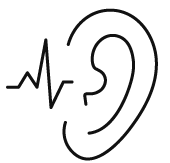Knowing more about how the ear works can help you to understand what’s going on with your hearing and balance. People with balance problems don’t always realise that their ears might be the cause, but learning more about the physiology of the ear may help you to see which type of support you could benefit from.
PHYSIOLOGY OF THE EAR
Here’s an overview of what you need to know about the physiology of the ear:
The outer ear
The outer ear consists of the pinna (also known as the auricle) and the auditory canal. The purpose of the outer ear is to collect sound waves (which are simply differences in air pressure over time) from the surrounding environment, channelling them through towards the ear drum.
The outer ear also plays an important role in the sound localisation process. It’s estimated that the outer ear amplifies the sound level at the ear drum six-fold.
The middle ear
The middle ear is an air-filled cavity that is separated from the outer ear by the tympanic membrane (ear drum). Along with the ear drum, it is also the site of the ossicular chain, which is a bridge-like structure comprised of the three smallest bones in the human body: the malleus, incus and stapes. Together, these transmit vibrations from the ear drum through to the oval window of the cochlea (organ of hearing). When sound waves reach the ear drum, it leads to the drum vibrating according to the pattern of the movement of the impacting wave - a key part of how the ear works.
The ear drum vibrates slowly in response to low frequencies and rapidly in response to high frequencies. The structure of the middle ear is such that it is designed to act as a ‘lever’, and is therefore able to amplify the sound wave vibrations impacting the ear drum through to the inner ear 20-fold.
The physiology of the middle ear also includes the eustachian tube, which opens up at the rear end of the throat, and allows for the pressure on both sides of the ear drum to be equalised for healthy transmission of sound vibration.

How The Ear Works: Hearing
Here’s how the physiology of the ear helps you to hear: when the ossicular chain of the middle ear conducts sounds to the oval window (a membrane located on the cochlea, connecting it to the middle ear), the fluids of the cochlea begin to move, stimulating the hair cells inside.
These hair cells send electrical impulses through the auditory nerve to the brain where they will be interpreted as sound.

How The Ear Works: Balance
The intricate physiology of the ear also impacts your balance. Angular and linear accelerations of the head and body cause displacement of the fluids within the vestibular organs. This in turn stimulates their hair cells, which then transmit impulses through the vestibular nerve to the brain. The brain then determines the relative positions of the head and body in relation to your environment, and responds by ensuring the necessary adjustments are made by your eyes and body to ensure balance is maintained*.
